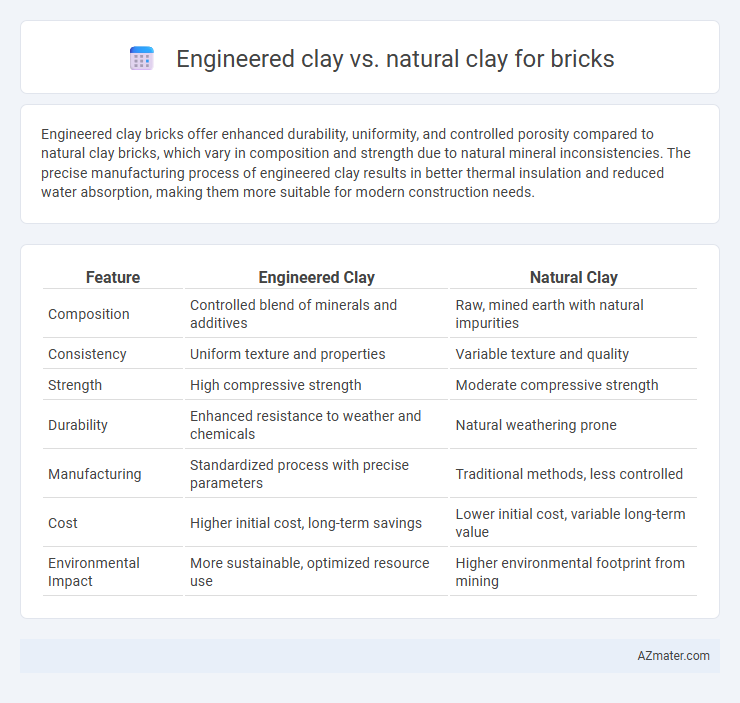Engineered clay bricks offer enhanced durability, uniformity, and controlled porosity compared to natural clay bricks, which vary in composition and strength due to natural mineral inconsistencies. The precise manufacturing process of engineered clay results in better thermal insulation and reduced water absorption, making them more suitable for modern construction needs.
Table of Comparison
| Feature | Engineered Clay | Natural Clay |
|---|---|---|
| Composition | Controlled blend of minerals and additives | Raw, mined earth with natural impurities |
| Consistency | Uniform texture and properties | Variable texture and quality |
| Strength | High compressive strength | Moderate compressive strength |
| Durability | Enhanced resistance to weather and chemicals | Natural weathering prone |
| Manufacturing | Standardized process with precise parameters | Traditional methods, less controlled |
| Cost | Higher initial cost, long-term savings | Lower initial cost, variable long-term value |
| Environmental Impact | More sustainable, optimized resource use | Higher environmental footprint from mining |
Introduction to Engineered and Natural Clay
Engineered clay bricks are manufactured using carefully controlled processes that enhance consistency, strength, and durability, making them ideal for modern construction needs. Natural clay bricks are sourced directly from mined clay and shaped through traditional methods, offering unique textures and color variations due to inherent mineral compositions. Both types of clay bricks serve as essential building materials, but engineered clay provides improved performance through technological refinement of raw materials.
Composition Differences between Engineered and Natural Clay
Engineered clay bricks are composed of a carefully controlled mix of raw materials, including kaolin, silica, and feldspar, designed for uniform particle size and chemical composition, enhancing brick strength and durability. Natural clay bricks are made from naturally occurring clay deposits with variable mineral content and impurities, leading to inconsistencies in texture and mechanical properties. The precise formulation in engineered clay ensures predictable firing behavior and improved performance compared to the heterogeneous nature of natural clay.
Manufacturing Processes of Engineered Clay Bricks
Engineered clay bricks are produced through a controlled manufacturing process involving the precise mixing of natural clay with additives such as fly ash, cement, and other stabilizers to enhance strength and durability. This mixture undergoes mechanized molding, high-pressure compaction, and kiln firing at optimized temperatures to ensure uniform density and reduced porosity. Compared to natural clay bricks, engineered clay bricks offer improved dimensional accuracy, faster curing times, and greater resistance to cracking and environmental degradation.
Production of Bricks Using Natural Clay
Production of bricks using natural clay involves extracting raw clay directly from deposits, followed by shaping and firing to harden the material, relying on its inherent mineral composition for strength. Natural clay bricks exhibit variability in texture, color, and plasticity due to impurities and organic content present in the clay source. This traditional method emphasizes minimal processing, contributing to a sustainable approach but often results in bricks with less uniformity compared to engineered clay alternatives.
Mechanical Strength Comparison: Engineered vs Natural Clay Bricks
Engineered clay bricks exhibit significantly higher mechanical strength compared to natural clay bricks due to controlled composition and advanced manufacturing processes. Natural clay bricks often contain impurities and inconsistent mineral content, leading to variable compressive strength typically ranging from 7 to 15 MPa. Engineered clay bricks can achieve compressive strengths exceeding 30 MPa, enhancing durability and load-bearing capacity in construction applications.
Thermal Performance and Insulation Properties
Engineered clay bricks exhibit superior thermal performance due to their controlled composition and uniform density, resulting in enhanced insulation properties compared to natural clay bricks. The engineered clay's optimized pore structure reduces heat transfer, providing better energy efficiency in buildings. Natural clay bricks offer moderate insulation but show more variability in thermal conductivity due to inconsistent material composition and firing processes.
Environmental Impact and Sustainability
Engineered clay bricks offer improved durability and energy efficiency during manufacturing, reducing carbon emissions compared to natural clay bricks traditionally fired at higher temperatures. Natural clay mining often leads to soil degradation and habitat disruption, whereas engineered clay uses optimized raw materials to minimize environmental footprint. Sustainable brick production increasingly favors engineered clay for its lower resource consumption and enhanced recyclability, supporting eco-friendly construction practices.
Cost Analysis: Engineered Clay vs Natural Clay
Engineered clay bricks typically incur higher initial costs due to advanced manufacturing processes and additives enhancing durability and uniformity, while natural clay bricks often present lower raw material expenses but greater variability in quality and increased labor costs. Over time, engineered clay bricks may result in reduced maintenance and replacement expenses, offering better long-term value compared to natural clay bricks prone to weathering and inconsistent strength. Cost analysis must factor in lifecycle expenses, including energy efficiency, structural performance, and regional availability impacting procurement prices for both engineered and natural clay bricks.
Durability and Longevity of Bricks
Engineered clay bricks exhibit enhanced durability and longevity compared to natural clay bricks due to their controlled composition and firing processes, resulting in uniform strength and reduced porosity. Natural clay bricks, while traditional and eco-friendly, often show variability in durability because of inconsistencies in raw material quality and firing temperatures. Advances in engineered clay technology contribute to bricks that resist weathering, erosion, and structural degradation over extended periods.
Applications and Suitability for Construction Projects
Engineered clay bricks offer enhanced uniformity, strength, and durability, making them ideal for high-load bearing structures and precision architectural designs. Natural clay bricks provide excellent thermal insulation and aesthetic variation, suitable for traditional and low-cost construction projects. Selection depends on factors like required structural performance, environmental conditions, and budget constraints in construction planning.

Infographic: Engineered clay vs Natural clay for Brick
 azmater.com
azmater.com